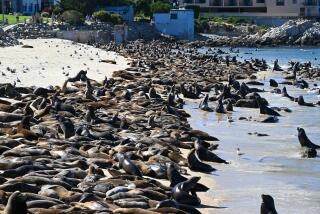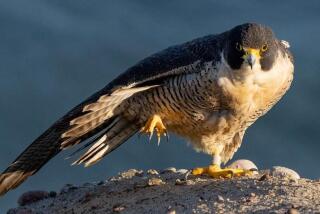Bald Eagles Released on Island but Soaring Can Wait
- Share via
The triumphant return of bald eagles to Channel Islands National Park was somewhat muted Tuesday morning when the four young raptors refused to leave their nesting boxes on Santa Cruz Island, where they have spent the past five weeks.
The boxes were opened as a crowd watched from a foggy hillside, but the eagles didn’t budge, preferring to dither on their perches instead. Park officials said one bird finally flew out about 7 p.m. and was last seen standing on the grass near the 15-foot tower supporting the nesting boxes.
“The point is, today the birds are free, the doors are open,” park spokesman Tom Dore said. “It’s selfish of us to expect a show.”
The release of the birds marks the first time in 50 years that bald eagles have been free to roam the national park, as their ancestors did before being driven off by DDT poisoning.
The first four eaglets--Sam, Gimpy, Big Mama and Chatty--are pioneers in a five-year effort to restore bald eagles to the island. These first birds will be joined by eight more later this year. The goal is to release 12 eagles annually for the next five years on the 65,000-acre island, park officials said.
“We think these will be a good core group that will stay here,” said David Garcelon, president of the Institute for Wildlife Studies in Arcata, which is managing the eagle program. “Wherever eagles learn to fly is the place they tend to regard as home.”
Each of the 12-week-old eagles has a satellite transmitter strapped to its back and a blue patch with a number under its wing to help track its movements. Garcelon said bald eagles restored to Santa Catalina Island in 1980 have traveled to Oregon, Washington, Nevada and Northern California, but usually return to the island, which is not part of the park chain.
The Santa Cruz eagles, which were hatched at the San Francisco Zoo, seemed itching to fly Tuesday. They flapped in their boxes and stared into misty Chinese Harbor, 800 feet down the hillside. Biologists caring for the eagles say they have flapped so hard they actually hovered like helicopters in their boxes.
“I have no fear that they will fly when the time comes,” biologist Jessica Dooley said.
The project’s funding comes from a $140-million settlement reached in 2000 between the government and Montrose Chemical Co. in Torrance. The business was accused of dumping millions of pounds of toxic DDT and PCBs into the ocean near Los Angeles from 1947 until 1972.
The chemicals poisoned fish and mammals, and caused the eggshells of birds like the bald eagle to get so thin they wouldn’t hatch.
More to Read
Sign up for Essential California
The most important California stories and recommendations in your inbox every morning.
You may occasionally receive promotional content from the Los Angeles Times.










